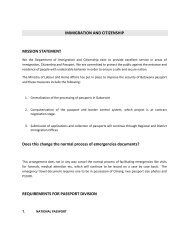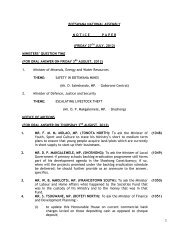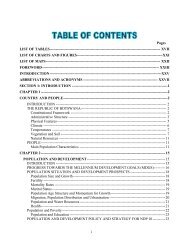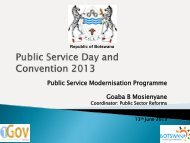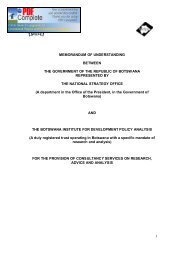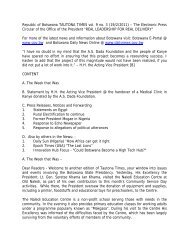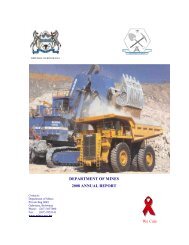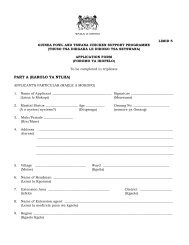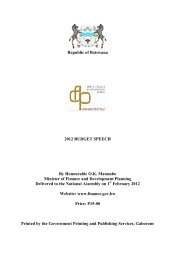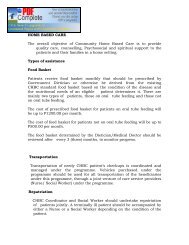Roads Department - Government of Botswana
Roads Department - Government of Botswana
Roads Department - Government of Botswana
You also want an ePaper? Increase the reach of your titles
YUMPU automatically turns print PDFs into web optimized ePapers that Google loves.
<strong>Roads</strong> <strong>Department</strong><br />
Salt measurement<br />
In the first instance, total dissolved salts (TDS) will normally be measured,<br />
however it is useful to have some indication <strong>of</strong> the dominant salt type for more<br />
detailed design and construction control particularly if salt levels are significant.<br />
The Electrical Conductivity (EC) should be measured. The correlation between<br />
the quick EC and the TDS measurements, for the <strong>Botswana</strong> field trials, where<br />
the TDS was measured according to the method given in BS 1377:Part 3, was:<br />
TDS = 0.04 + 0.16 EC.<br />
A correlation coefficient <strong>of</strong> 0.9 was obtained for this relationship. All determinations<br />
were carried out on the minus 2 mm fraction <strong>of</strong> the samples, corresponding<br />
to about 75% by mass <strong>of</strong> the borrow pit material. The major<br />
proportion <strong>of</strong> the salt is contained in the fines.<br />
The salt content <strong>of</strong> water and materials should each be determined separately.<br />
The risk assessment in this guideline takes into account the combined influence<br />
<strong>of</strong> each.<br />
Salt from compaction water is potentially more<br />
harmful than salt contained in the materials<br />
due to the ability <strong>of</strong> salt in water to rise more<br />
rapidly to the road surface.<br />
Obtaining Materials and Water rating ( ‘M’ Value)<br />
Using the appropriate salt levels for materials and water determine the weighting<br />
value M from Figure 4.2. A M value <strong>of</strong> 10 should be adopted if the pavement<br />
or subgrade salinity exceeds 0.8% TDS irrespective <strong>of</strong> compaction water<br />
salinity.<br />
1.0<br />
Pavement or subgrade material salinity<br />
Total Soluble Salts TSS (%)<br />
0.8<br />
0.6<br />
0.4<br />
0.2<br />
Compaction water salinity<br />
(see key)<br />
5.0<br />
4.0<br />
3.0<br />
2.0<br />
1.0<br />
Pavement or subgrade material salinity<br />
Electrial Conductivity E.C (mS/cm)<br />
(For <strong>Botswana</strong> Conditions)<br />
0<br />
0 2 4 6 8 10<br />
M value<br />
0<br />
Key:<br />
Compaction water salinity<br />
Fresh 0 - 0.5%<br />
Brackish 0.5 - 1.0 %<br />
Saline >1.0<br />
Notes:<br />
For Pavement/subgrade material,<br />
with TSS levels in excess <strong>of</strong> 0.8%<br />
use an M value <strong>of</strong> 10, irrespective <strong>of</strong><br />
compaction water salinity.<br />
Figure 4.2 Materials risk rating-salt damge to bituminous surfacings.<br />
30 Chapter 4<br />
Guide to the Prevention and Repair <strong>of</strong> Salt Damage to <strong>Roads</strong> and Runways<br />
Risk Evaluation in Saline Environments



